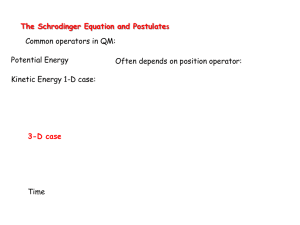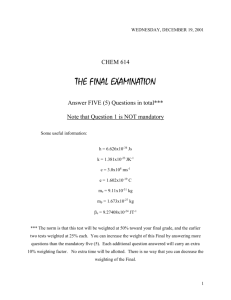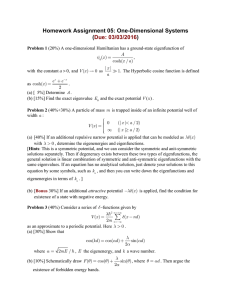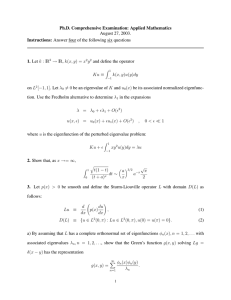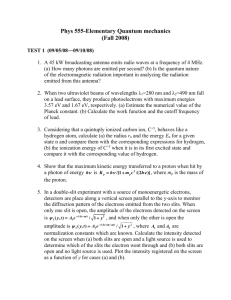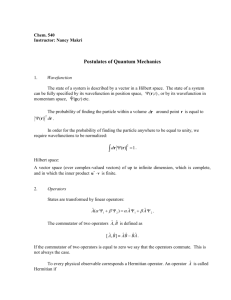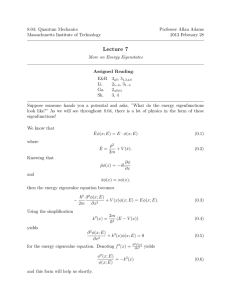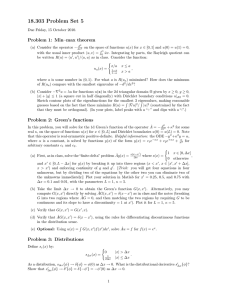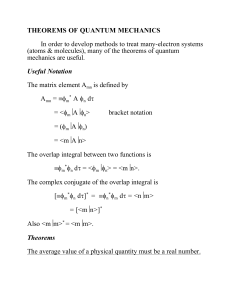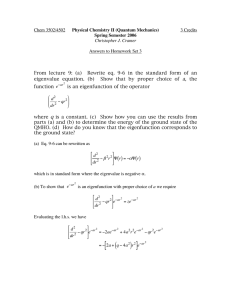( ) THE POSTULATES OF QUANTUM MECHANICS ψ
advertisement
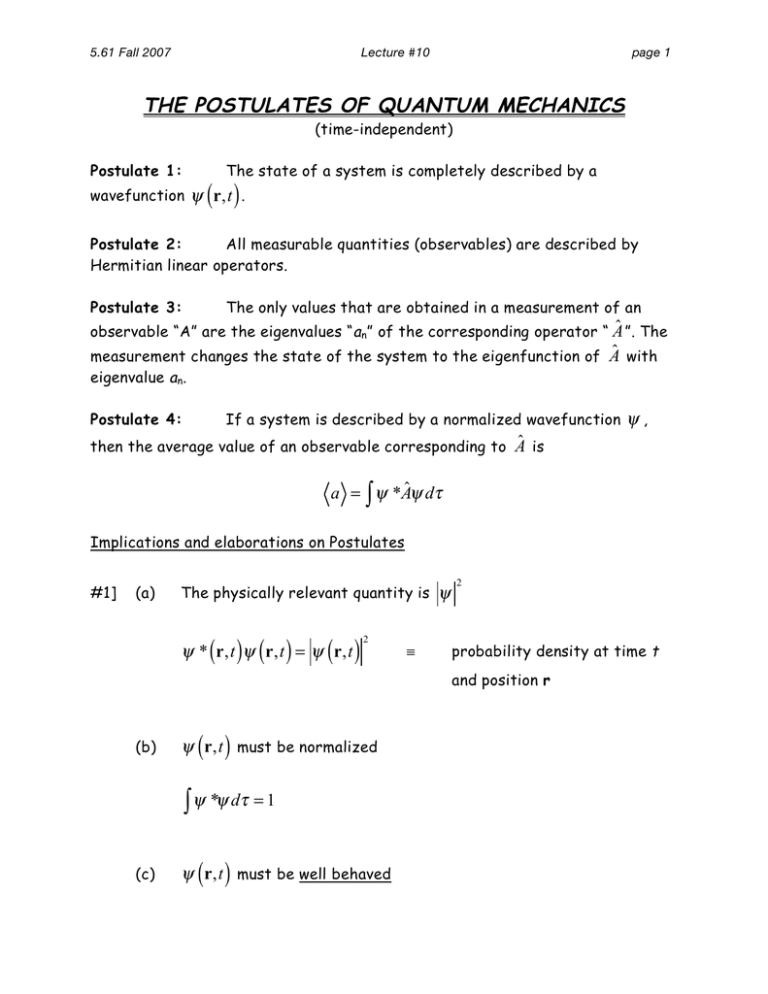
5.61 Fall 2007 Lecture #10 page 1 THE POSTULATES OF QUANTUM MECHANICS (time-independent) Postulate 1: The state of a system is completely described by a ( ) wavefunction ψ r,t . Postulate 2: All measurable quantities (observables) are described by Hermitian linear operators. Postulate 3: The only values that are obtained in a measurement of an observable “A” are the eigenvalues “an” of the corresponding operator “  ”. The measurement changes the state of the system to the eigenfunction of  with eigenvalue an. Postulate 4: If a system is described by a normalized wavefunction ψ, then the average value of an observable corresponding to  is a = ∫ ψ *Âψ dτ Implications and elaborations on Postulates #1] (a) The physically relevant quantity is ψ ( ) ( ) ( ) ψ * r,t ψ r,t = ψ r,t 2 ≡ 2 probability density at time t and position r (b) ( ) ψ r,t must be normalized ∫ ψ *ψ dτ = 1 (c) ( ) ψ r,t must be well behaved 5.61 Fall 2007 #2] (a) Lecture #10 (i) (ii) Single valued ψ and ψ ′ continuous (iii) Finite Example: () () Particle in a box eigenfunctions of Ĥ () Ĥ x ψ n x = Enψ n x But if page 2 ψn ⎛ 2⎞ x =⎜ ⎟ ⎝ a⎠ () 12 ⎛ nπ x ⎞ sin ⎜ ⎝ a ⎟⎠ ψ is not an eigenfunction of the operator, then the statement is not true. e.g. () ψ n x above with momentum operator 12 ⎛ nπ x ⎞ ⎤ d d ⎡⎛ 2 ⎞ ⎥ p̂nψ n x = −i! ψ n x = −i! ⎢⎜ ⎟ sin ⎜ dx dx ⎢⎝ a ⎠ ⎝ a ⎟⎠ ⎥ ⎣ ⎦ ⎡⎛ 2 ⎞ 1 2 ⎛ nπ x ⎞ ⎤ ≠ pn ⎢⎜ ⎟ sin ⎜ ⎟⎠ ⎥ a a ⎝ ⎠ ⎝ ⎢⎣ ⎥⎦ () (b) In order to create a Q.M. operator from a classical observable, use x̂ = x and e.g. () p̂x = −i! d and replace in classical expression. dx 1 2 1 !2 d 2 K.E. = p̂ = p̂ p̂ = − (1D) 2m 2m 2m dx 2 !2 ⎛ ∂2 ∂2 ∂2 ⎞ =− + + (3D) 2m ⎜⎝ ∂x 2 ∂y 2 ∂z 2 ⎟⎠ ( )( ) Another 3D example: Angular momentum L=r×p 5.61 Fall 2007 Lecture #10 page 3 ⎛ d d⎞ lx = ypz − zp y = −i! ⎜ y − z ⎟ dy ⎠ ⎝ dz ⎛ d d⎞ l y = zpx − xpz = −i! ⎜ z −x ⎟ dz ⎠ ⎝ dx ⎛ d d⎞ lz = xp y − ypx = −i! ⎜ x − y ⎟ dx ⎠ ⎝ dy (c) Linear means () () () () () () ˆ x + Ag ˆ x  ⎡⎣ f x + g x ⎤⎦ = Af  ⎡⎣ cf x ⎤⎦ = c ⎡⎣ f x ⎤⎦ (d) and Hermitian means that ( ) ∗ ∗ ∫ ψ 1 Âψ 2 dτ = ∫ ψ 2 Âψ 1 dτ and implies that the eigenvalues of  are real. This is important!! Observables should be represented as real numbers. Take Âψ = aψ Proof: ( ) ( ) dτ ∗ ∫ ψ Âψ dτ = ∫ ψ Âψ ∫ψ ⇒ ∗ ( ) aψ dτ = ∫ ψ aψ ∗ ∗ dτ a = a* true only if a is real (e) Eigenfunctions of Hermitian operators are orthogonal i.e. if Âψ m = amψ m and Âψ n = anψ n 5.61 Fall 2007 Lecture #10 then ∫ψ ψ n dτ = 0 ∗ m page 4 if m ≠ n Proof: ( ) ∗ ∗ ∫ ψ m Âψ n dτ = ∫ ψ n Âψ m dτ an ∫ ψ m∗ ψ n dτ = am∗ ∫ ψ nψ m∗ dτ (a ⇒ n (a n − am∗ ) ∫ψ ∗ m − am∗ ) ∫ψ ∗ m ψ n dτ = 0 = 0 if n=m Example: ψ n dτ = 0 = 0 if n ≠ m Particle in a box ψ4 As much + as - area ψ 1∗ψ 4 000aaadxdxdxψψψψψψ 140130120 ψ3 Eigenfunctions ˆH of ψ 1∗ψ 3 ⇒ ψ2 ψ 1∗ψ 2 ψ1 0 x a 0 x a In addition, if eigenfunctions of  are normalized, then they are orthonormal ∫ψ ψ n dτ = δ mn ∗ m Krönecker delta 5.61 Fall 2007 Lecture #10 page 5 ⎧1 if m = n (normalization) δ mn = ⎨ ⎩0 if m ≠ n (orthogonality) #3] If ψ is an eigenfunction of the operator, then it’s easy, e.g. Ĥψ n = Enψ n But what if e.g. measurement of energy yields value E n ψ is not an eigenfunction of the operator? ψ could be a superposition of eigenfunctions ψ = c1φ1 + c2φ2 Âφ1 = a1φ1 where and Âφ2 = a2φ2 2 2 Then a measurement of A returns either a1 or a2 , with probability c1 or c2 respectively, and making the measurement changes the state to either φ1 or φ2 . a1 a 1 ψ measure #4] a 2a2 φ1 (probability c12 ) φ2 (probability c22 ) This connects to the expectation value (i) If ψ n is an eigenfunction of  , then Âψ n = anψ n a = ∫ ψ n∗ Âψ n dτ = an ∫ ψ n∗ψ n dτ = an a = an only value possible 5.61 Fall 2007 (ii) Lecture #10 page 6 If ψ = c1φ1 + c2φ2 as above a = ∫ ψ ∗ Aˆψ dτ = ∫ (c φ 1 1 ) ( ) ∗ + c2φ2 Aˆ c1φ1 + c2φ2 dτ = c12 a1 + c22 a2 c12 is the probability of measuring a1 <a > = average of possible values weighted by their probabilities
